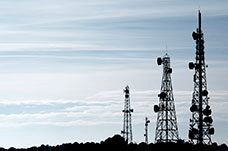If you watched television anytime during the past decade, then chances are you are familiar with the Verizon Wireless ad campaign that featured a bespectacled Verizon employee roaming the far reaches of the United States asking the question, “Can you hear me now?” This ad campaign was seemingly inescapable, and proved to be wildly successful, growing into its own pop culture phenomenon. Several diverse factors likely contributed to the success of this campaign, but arguably one of the primary reasons for it’s overall popularity was that the actor’s situation was all too relatable to the millions who use a mobile phone. Who hasn’t lost mobile phone service at one point or another? Even those who reside in the most developed of metropolitan centers, where every form of media and communication is at our disposal, are not immune to the plight of the “dropped” call.
This begs the question as to why, even in a time and place where we can receive hundreds of HD cable channels, download an album in seconds, or get continuous satellite radio feeds, does mobile phone service seem at times so inconsistent? The answer, as you might expect, is multi-layered. Various levels of national, state, and local rules and regulations govern mobile phone service and the placement and operation of cell sites (e.g., cell masts or towers). The physical presence of these cell sites is the necessary component to reliable mobile phone service and determines the strength of mobile phone signals. As necessary as these cell sites are to our modern forms of communication, the construction of these towers can sometimes be a lengthy and costly venture.
While there is an increasing need for new and expanded mobile phone service in most areas, the majority of municipalities place restrictions on the placement and development of cell sites in their jurisdiction, requiring that the antennas, transceivers, and other physical improvements are inconspicuous and blend with the character and aesthetics of the surrounding environment. This is commonly accomplished by constructing a concealed or stealth cell site, which can camouflage cell towers amongst artificial trees, flag poles, rocks, water towers, or existing building facades.
Once the proponent of the cell site has sufficiently proven compliance with local design requirements and cleared local review, the cell site development process moves to the state and federal levels of review. The construction and operation of cell sites is governed by the Federal Communication Commission (FCC), and as a licensing agency, the FCC requires licensees and applicants to evaluate the potential environmental impacts of their proposed actions under the National Environmental Policy Act (NEPA). In many instances, the proponent must consider the potential environmental effects from the construction of antennas and  other improvements, and disclose those effects in a short-form Environmental Assessment (EA). The FCC reviews the document and solicits public comment on the EA, while also assisting the proponent with navigating the requirements of the appropriate local, state, and federal agencies with jurisdiction over the development of the cell site.
other improvements, and disclose those effects in a short-form Environmental Assessment (EA). The FCC reviews the document and solicits public comment on the EA, while also assisting the proponent with navigating the requirements of the appropriate local, state, and federal agencies with jurisdiction over the development of the cell site.
The preparation and submission of an EA is required when a proposed facility could have a significant impact on a historic property. Under the National Historic Preservation Act (NHPA), the FCC is required to consider the effects of federal undertakings on historic resources. Project proponents must comply with NHPA procedures when their proposed cell sites may affect historic sites listed or eligible for listing in the National Register of Historic Places. This process includes consultation with the relevant State Historic Preservation Officer (SHPO) or Tribal Historic Preservation Officer (THPO) if the proposed facility may create an adverse effect on an eligible or listed historic property. In addition to determining a cell site’s potential impacts on historic resources, the NEPA process also includes an evaluation of environmental impacts to sensitive biological species and habitats under the Endangered Species Act.
The steps outlined above is just a cursory summary of the cell site development process, and does not even take into account a myriad of other environmental impact assessments that are often also required independent from the realm of NEPA, including the evaluation of the onsite presence of potentially hazardous materials because of past activities. 
While service providers are continuing to construct facilities at a fevered pace, the design and environmental compliance requirements can somewhat temper the development process. So while you’ll likely be just as frustrated the next time you find yourself without any service bars, you will have a better understanding as to why.
FirstCarbon Solutions is an industry leader in environmental compliance services needed by all of the leading mobile service providers, assisting FCC licensees and applicants with getting their cell sites operational in a timely and cost effective manner throughout mainland United States and Hawaii. Contact FirstCarbon Solutions today to find out how we can help your company:





